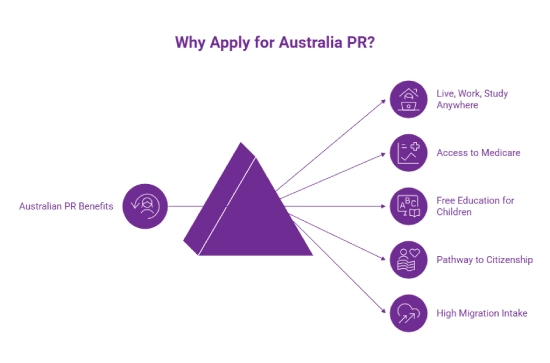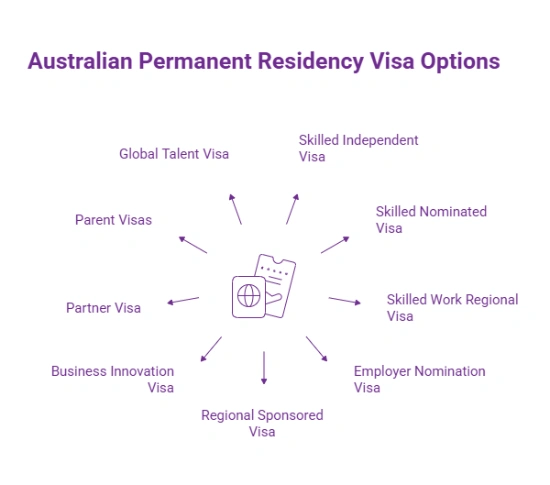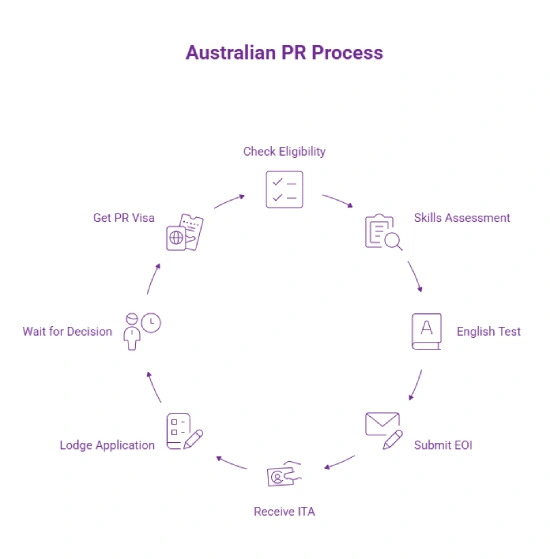Why Apply for an Australian PR?
- Live, work, and study anywhere in Australia
- Access to Medicare-Australia’s public healthcare system
- Free education for children in public schools
- Pathway to Australian citizenship after 4 years of stay
- Australia welcomed over 190,000 permanent migrants in 2023-24 under its Migration Program
Australia offers a high standard of living, world-class infrastructure, and abundant career opportunities for skilled professionals. With permanent residency (PR), you can enjoy nearly all the rights of an Australian citizen, making it an ideal pathway for those looking to settle long-term.

What is Australia PR?
Australian Permanent Residency (PR) is a visa status that allows foreign nationals to live, work, and study in Australia indefinitely. PR holders enjoy most of the benefits that Australian citizens do, including access to healthcare, education, and social security (after a qualifying period). It also serves as a pathway to Australian citizenship after fulfilling residency requirements.
Here are some Do’s and Don’ts for an Australian PR Visa:
|
Do’s |
Don’ts |
|
Maintain valid residency and meet stay rules |
Do not overstay or breach visa conditions |
|
File taxes and declare global income |
Avoid giving false information on applications |
|
Keep your documents updated and accurate |
Don’t ignore PR renewal or citizenship eligibility |
|
Apply for Medicare and other entitlements |
Don’t assume PR is the same as citizenship |
|
Follow immigration and employment laws |
Avoid relying on unverified or unofficial advice |
*Want to apply for Australian PR? Sign up with Y-Axis to guide you with the process.
Can UK Residents be Permanent Residents of Australia?
Yes, UK residents can become Permanent Residents (PR) of Australia by applying through various visa pathways such as the Skilled Independent Visa (subclass 189), Employer-Sponsored Visas, or through family and partner sponsorships. Australia’s PR process is points-based and considers factors such as age, education, work experience, English proficiency, and occupation demand.
Many skilled professionals from the UK are eligible under the General Skilled Migration (GSM) program, especially if their occupation is listed on Australia's Skilled Occupation List (SOL). Once granted, a PR visa allows UK residents to live, work, and access services in Australia indefinitely and eventually apply for Australian citizenship after meeting residency requirements.
Australian Permanent Resident vs. Australia Citizenship
While both Australian Permanent Residency (PR) and Citizenship offer the right to live and work in Australia, there are key differences in terms of rights, responsibilities, and benefits. Here's a comparison across major factors:
|
Factor |
Australian PR |
Australian Citizenship |
|
Right to Live and Work |
Indefinite stay with full work rights |
Full rights and protections as a citizen |
|
Voting Rights |
Not allowed |
Allowed in all local, state, and federal elections |
|
Australian Passport |
Not eligible |
Eligible for an Australian passport |
|
Government Jobs |
Limited eligibility |
Eligible for all government roles |
|
Political Participation |
Cannot run for office |
Can vote and stand for election |
|
Consular Assistance |
Limited overseas assistance |
Full consular support while abroad |
|
Healthcare (Medicare) |
Full access |
Full access |
|
Citizenship for Children |
Children born are not automatically citizens |
Children born are automatically citizens |
|
Travel Flexibility |
Requires valid travel facility on PR visa |
Unrestricted travel with Australian passport |
|
Deportation Risk |
Can be revoked for criminal activity |
Protected unless citizenship is revoked |
Australia PR Process
The Australian Permanent Residency (PR) process involves a structured pathway for skilled individuals and families aiming to live and work in Australia permanently. It includes assessment, invitation, and visa application stages.
The 3 Stages in the Australia PR Process:
Step 1: Eligibility Check & Skill Assessment
Submit your skills for assessment through a recognized assessing authority based on your nominated occupation.
Step 2: Expression of Interest (EOI) & Invitation
Create and submit an EOI via SkillSelect. High-ranking candidates receive an invitation to apply for PR.
Step 3: Visa Application & Grant
Apply for the visa within 60 days of invitation. Submit documents, undergo health checks, and wait for the final PR grant.
Some of the Australia visa options to become a Permanent Residents of Australia are as follows:
- Skilled Independent Visa (Subclass 189)
- Skilled Nominated Visa (Subclass 190)
- Skilled Work Regional (Provisional) Visa (Subclass 491)
- Employer Nomination Scheme Visa (Subclass 186)
- Regional Sponsored Migration Scheme Visa (Subclass 187)
- Business Innovation and Investment Visa (Subclass 888)
- Partner Visa (Subclass 801/100)
- Parent Visas
- Global Talent Visa (Subclass 858)

Australia 189 Visa – Skilled Independent Visa
The Subclass 189 Visa is a points-tested permanent residency visa for skilled workers who are not sponsored by an employer, state, or territory. It allows individuals to live and work anywhere in Australia permanently. To be eligible, applicants must submit an Expression of Interest (EOI) through SkillSelect and receive an invitation to apply. This visa is ideal for high-demand professionals with skills listed on the Medium and Long-term Strategic Skills List (MLTSSL).
Australia 190 Visa – Skilled Nominated Visa
The Subclass 190 Visa is a state-nominated permanent residency visa for skilled workers with occupations in demand in specific Australian states or territories. Applicants must first receive a nomination from a state or territory government and meet the eligibility criteria, including a minimum points threshold. This visa provides permanent residency and requires the holder to live and work in the nominating state for at least two years after arrival.
Australia PR eligibility
To be eligible for Permanent Residency (PR) in Australia, applicants must meet specific criteria set by the Department of Home Affairs. These requirements ensure that individuals contribute positively to the Australian economy and society. The eligibility is based on a points-tested system that factors in age, skills, language proficiency, and more. Meeting all criteria enhances your chances of receiving an invitation to apply for PR.
- Age: Must be under 45 years
- English Proficiency: IELTS or equivalent required
- Skilled Occupation: Must be on relevant list
- Skills Assessment: Positive assessment from authorized body
- Work Experience: Relevant to nominated occupation
- Points Score: Minimum 65 points required
.webp)
*Check your eligibility to become a Permanent Resident of Australia with the FREE Y-Axis Australia immigration Points Calculator and get an instant score!
Australia PR requirements
To apply for Permanent Residency (PR) in Australia, candidates must satisfy a range of criteria outlined by the Department of Home Affairs. These requirements ensure that migrants possess the necessary skills, qualifications, and adaptability to contribute effectively to the country’s economy and society.
The table below has an overview of the eligibility factors for Australia PR:
|
Category |
Maximum Points |
|
Age (25-32 years) |
30 points |
|
English proficiency (8 bands) |
20 points |
|
Work Experience outside Australia (8-10 years) |
15 points |
|
Work Experience in Australia (8-10 years) |
20 points |
|
Education (outside Australia) – Doctorate degree |
20 points |
|
Niche skills such as Doctorate or master’s degree by research in Australia |
10 points |
|
Study in a regional area |
5 points |
|
Accredited in community language |
5 points |
|
Professional year in a skilled program in Australia |
5 points |
|
State sponsorship (190 visa) |
5 points |
|
Skilled spouse or de facto partner (Age, Skills & English language requirements to be met) |
10 points |
|
Spouse or de facto partner with ‘competent English’ (No need to meet Skills requirement or age factor) |
5 points |
|
Applicants without a spouse or de facto partner or where a spouse is an Australian citizen or PR holder |
10 points |
|
Relative or regional sponsorship (491 visa) |
15 points |
Below are the key Australia PR requirements:
- Age: You must be under 45 years of age when you receive the invitation to apply.
- English Language Proficiency: You must demonstrate competent English, typically with an IELTS score of at least 6 in each band or equivalent.
- Occupation: Your occupation must be listed on one of Australia's Skilled Occupation Lists.
- Skills Assessment: You need to get a positive skills assessment from the relevant assessing authority for your nominated occupation.
- Points Score: You must score at least 65 points under the General Skilled Migration points-based system.
- Health Requirements: You must meet the health standards through a medical examination.
- Character Requirements: You need to provide police clearance certificates to prove good character.
- Proof of Funds: You may be asked to show financial stability to support yourself and dependents after arrival.
- Work Experience: Relevant work experience in your nominated occupation can strengthen your application.
- Educational Qualification: You must have the minimum educational qualification required for your nominated occupation.
How to get an Australian PR?
Securing Permanent Residency (PR) in Australia involves a structured process through skilled migration or other eligible visa categories. Below are the general steps to apply for Australian PR:
Step 1: Check Your Eligibility
Ensure you meet the basic eligibility criteria including age, occupation, English language proficiency, and points requirement (minimum 65 points).
Step 2: Get Your Skills Assessed
Apply for a skills assessment through the designated assessing authority for your nominated occupation. A positive assessment is essential for most PR visas.
Step 3: Take an English Language Test
Take a recognized test like IELTS, PTE, or TOEFL and meet the required score to demonstrate competent English proficiency.
Step 4: Submit an Expression of Interest (EOI)
Lodge an EOI through SkillSelect, indicating your interest in a PR visa. You will need to enter details like qualifications, work experience, and language scores.
Step 5: Receive an Invitation to Apply (ITA)
If your EOI is competitive, you will receive an ITA to apply for PR. Invitations are issued based on your points and occupation demand.
Step 6: Lodge Your Visa Application
Submit your visa application with all supporting documents including identity, education, employment proof, and health and character clearances.
Step 7: Wait for a Decision
The Department of Home Affairs will assess your application. Processing times vary depending on the visa subclass and individual circumstances.
Step 8: Get Your PR Visa
Once approved, you will receive your PR grant letter. You can now live, work, and study in Australia permanently.

Australia Skill Assessment
The Australia Skill Assessment is a mandatory step for skilled migration applicants seeking permanent residency. It evaluates whether your education, qualifications, and work experience match Australian standards for your nominated occupation. Each occupation is assessed by a designated authority (like ACS, Engineers Australia, VETASSESS, etc.), and the process must be completed before lodging your visa application. A positive skill assessment boosts your chances of receiving an invitation to apply through SkillSelect and is valid for up to 3 years in most cases.
Benefits of Australia Permanent Residency
Australia PR offers long-term settlement, work, and social benefits, making it a highly sought-after immigration pathway.
- Live, work, and study anywhere in Australia
- Access to Australia’s public healthcare system (Medicare)
- Pathway to Australian citizenship after 4 years
- Sponsor eligible family members for PR
- Travel in and out of Australia freely for 5 years
- Children born in Australia become citizens by birth
- Access to social security benefits after 2 years
- Right to pursue education with local tuition fees
- Protection under Australian law and legal system
- Eligibility for government job roles (in some sectors)
Jobs in Australia for UK Residents
Jobs in Australia for UK residents are abundant, especially for skilled professionals in sectors like healthcare, engineering, IT, construction, and education. With both countries sharing strong economic ties and English as the primary language, UK nationals often find it easier to transition into the Australian workforce. Australia’s SkillSelect program and General Skilled Migration (GSM) visa pathways offer UK professionals a streamlined route to work and settle permanently. Competitive salaries, excellent work-life balance, and high demand for skilled talent make Australia a top destination for UK job seekers.
|
Occupation |
Annual salary in AUD |
|
IT |
$81,000 – $149,023 |
|
Marketing & Sales |
$70,879 – $165,000 |
|
Engineering |
$87,392 – $180,000 |
|
Hospitality |
$58,500 – $114,356 |
|
Healthcare |
$73,219 – $160,000 |
|
Accounting & Finance |
$89,295 – $162,651 |
|
Human Resources |
$82,559 – $130,925 |
|
Teaching |
$75,284 – $160,000 |
|
Professional and Scientific Services |
$90,569 – $108,544 |
IT Jobs in Australia
Australia’s thriving digital economy is driving strong demand for IT professionals across sectors like software development, cybersecurity, data science, and cloud computing. With tech hubs in cities like Sydney, Melbourne, and Brisbane, the country offers lucrative opportunities, competitive salaries, and long-term career growth for skilled tech workers.
|
IT Job Title |
Average Annual Salary (AUD) |
|
Software Developer |
1,00,000 |
|
Data Scientist |
1,15,000 |
|
Cloud Solutions Architect |
1,35,000 |
|
Cybersecurity Specialist |
1,25,000 |
|
DevOps Engineer |
1,20,000 |
|
IT Project Manager |
1,30,000 |
|
Full Stack Developer |
1,10,000 |
|
Network Engineer |
1,05,000 |
|
Business Intelligence Analyst |
1,10,000 |
|
Machine Learning Engineer |
1,25,000 |
Total Cost for Australian PR
The total cost of applying for Australian Permanent Residency (PR) depends on the visa subclass, number of dependents, and additional services like English tests, skill assessments, and health checks. For a primary applicant, the base application fee starts from AUD 4,640, with added charges for a spouse and children. Applicants should also budget for other mandatory expenses such as language exams, biometrics, medicals, and police clearances.
Overall, the complete cost for a single applicant typically ranges between AUD 6,000 to AUD 8,000, while for families, it can go up to AUD 10,000–12,000, depending on the size and visa requirements.
Australia PR Visa Processing Times
The processing time for an Australia Permanent Residency (PR) visa varies depending on the visa subclass, applicant profile, and documentation. As per the Australian Department of Home Affairs, the general processing times are:
- Subclass 189 (Skilled Independent visa): 90% of applications processed in 6 to 8 months
- Subclass 190 (Skilled Nominated visa): 90% processed in 6 to 9 months
- Subclass 491 (Skilled Work Regional visa): Typically takes 7 to 12 months
Note: These timelines are only indicative and may vary based on application volume, completeness of documents, health and character checks, and verification procedures. To ensure faster processing, applicants should submit a complete and accurate application, along with all required supporting evidence.
Factors affecting the Australia PR Visa processing time
Several elements can influence how quickly your Australia PR visa is processed.
- Visa Subclass Type : Different PR pathways have varying processing timelines.
- Completeness of Application : Missing documents or incorrect details can cause delays.
- Demand for Occupation: Applications in high-demand occupations may be prioritized.
- Verification and Background Checks : Security, character, and health checks can affect speed.
- Department Workload : Processing times may vary based on overall volume of applications.
Tips to get your Australian PR visa processed on time
Applying for an Australian PR visa can be a smooth and timely process if approached with care and preparation. Ensuring your application is accurate, complete, and well-documented can significantly improve your chances of faster processing. Here are some essential tips to help avoid delays:
- Submit a Complete Application: Double-check all required documents and details before submission.
- Apply Under the Right Visa Subclass: Choose the correct visa stream based on your qualifications and goals.
- Ensure Valid English Test Scores: Include up-to-date IELTS, PTE, or TOEFL scores, if required.
- Provide Accurate Employment and Education Records: Avoid discrepancies to speed up background verification.
- Get a Positive Skill Assessment Early: Start the skills assessment process promptly to prevent delays later.
- Respond Quickly to Department Requests: If asked for additional documents, submit them without delay.
- Use a Registered Migration Agent: Consults experts at Y-Axis to help you avoid errors and ensure compliance.
How Can Y-Axis Help You?
Y-Axis, the leading overseas immigration consultancy in the UK, provides unbiased immigration services for every client based on their interests and requirements. The impeccable services of Y-Axis include:
- Free eligibility check through Australia Immigration Points Calculator
- Expert guidance/counseling for Australian Immigration
- Coaching services: Expert CELPIP coaching, IELTS proficiency Coaching
- Free career counseling; book your slot today
- Complete guidance for Australia PR visa
- Job search services to find related jobs in Australia
Looking for Inspiration
Explore what Global Citizens have to say about Y-Axis in shaping their future
Frequently Asked Questions
